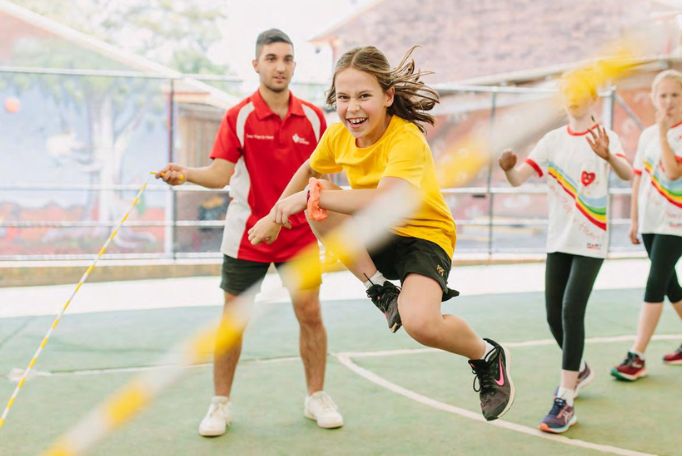Lesson summary
In this lesson, students consider their strengths and weaknesses and evaluate their overall skipping ability and stamina. They then set goals to improve their ability over time, in pursuit of more advanced skipping techniques, and potentially in preparation for a school Jump Off Day. Students record and graph data to visually represent their improvement.
Learning intentions:
Students will...
- build confidence and develop an awareness of their bodies, gross motor skills and rhythm
- build confidence in skipping equipment and processes
- understand how to measure and track progress
- understand how to set and work towards goals.
Success criteria:
Students can...
- perform some simple solo and group skipping skills
- use a stopwatch
- record and present data.
Lesson guides and printables
Lesson details
Curriculum mapping
Australian Curriculum content descriptions:
Foundation Year Health and Physical Education:
- Identify personal strengths (ACPPS001)
- Practise personal and social skills to interact positively with others (ACPPS004)
- Practise fundamental movement skills and movement sequences using different body parts (ACPMP008)
- Explore how regular physical activity keeps individuals healthy and well (ACPMP010)
- Follow rules when participating in physical activities (ACPMP014)
Years 1 & 2 Health and Physical Education:
- Explore actions that help make the classroom a healthy, safe and active place (ACPPS022)
- Perform fundamental movement skills in a variety of movement sequences and situations (ACPMP025)
- Create and participate in games with and without equipment (ACPMP027)
- Discuss the body’s reactions to participating in physical activities (ACPMP028)
- Incorporate elements of effort, space, time, objects and people in performing simple movement sequences (ACPMP029)
Year 1 Maths:
- Represent data with objects and drawings where one object or drawing represents one data value. Describe the displays (ACMSP263)
Year 2 Maths:
- Create displays of data using lists, table and picture graphs and interpret them (ACMSP050)
Syllabus outcomes: COES1.1, IPES1.11, MOES1.4, GSES1.8, GYES1.10, ALES1.6, SLS1.13, MOS1.4, GSS1.8, GYS1.10, ALS1.6, PHS1.12, MA1‑1WM, MA1‑2WM
General capabilities: Personal and Social Capability
Relevant parts of Foundation Year Health and Physical Education achievement standards: Students perform fundamental movement skills and solve movement challenges. They demonstrate how to move and play safely. Students use personal and social skills when working with others in a range of activities. They describe how their body responds to movement.
Relevant parts of Year 1 & 2 Health and Physical Education achievement standards: Students identify areas where they can be active and how the body reacts to different physical activities. They demonstrate fundamental movement skills in a variety of movement sequences and situations and test alternatives to solve movement challenges.
Relevant parts of Year 1 Mathematics achievement standards: They collect data and draw simple data displays
Relevant parts of Year 2 Mathematics achievement standards: Students collect, organise and represent data
This lesson is part of the wider unit of work Jump Rope For Heart: Jump Starters – Years F-2
Time required: 50 mins
Level of teacher scaffolding: Medium – teacher facilitates skipping movements skills.
Resources required
- Basketball court, tennis court, stadium, or open outdoor area
- Graph paper or maths book
- Pencils or pens
- Skipping Record Sheet – one copy per student
- Skipping ropes – short – one per student
- Stopwatch – one per pair
Skills
This lesson is designed to build students’ competencies in the following skills:
- Communication
- Social skills
- Collaboration
Additional info
The Heart Foundation’s ready-made skipping program, Jump Rope for Heart, helps primary school students move more and have fun, while they raise funds for heart research, patient support and programs that help save lives.


Welcome back!
Don't have an account yet?
Log in with:
By signing up to Cool.org you consent and agree to Cool's privacy policy to
store, manage and process your personal information. To read more, please see
our privacy policy here(Opens in new tab).
Create your free Cool.org account.
Many of our resources are free, with an option to upgrade to Cool+ for premium content.
Already have an account?
Sign up with:
By signing up to Cool.org you consent and agree to Cool's privacy policy to
store, manage and process your personal information. To read more, please see
our privacy policy here(Opens in new tab).